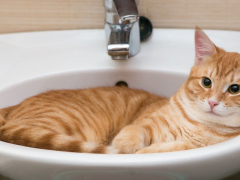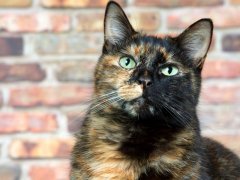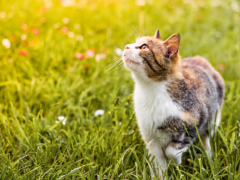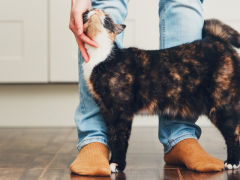
Melina Grin / Cats.com
Cats might have peeing accidents in the house due to underlying medical conditions, stress, litter box aversion, or a problematic owner. In this article, we’ll explore these potential triggers and offer practical solutions to create a more harmonious environment for your feline friend. With the right approach, you can help your cat feel secure and comfortable, preventing the chances of inappropriate urination.
Possible Root Causes of House Soiling
It can be puzzling and frustrating if your cat has started urinating in your home. The good news is that you can address this issue effectively by identifying the root causes and taking steps to prevent it from happening again.
Let’s identify some potential causes:
Medical Conditions and Other Health Issues
There are several medical reasons why cats may urinate in the house. These include feline idiopathic cystitis, urinary tract infections, bladder stones, urethral obstructions, kidney disease, and other health problems that can impact their urinary tract.
A 2016 study conducted by Trupanion found that drinking hard tap water may be linked to a higher risk of feline lower urinary tract disease (FLUTD) than filtered water in some areas of the United States. Moreover, scientific evidence indicates that a diet high in minerals such as sodium, phosphorus, and magnesium can cause urinary stones in cats and affect their bathroom habits.
Although it’s uncommon and no scientific evidence supports this, a cat may urinate outside the litter box if its sense of smell is diminished due to an upper respiratory infection (URI). For example, a nose or sinus infection can cause nasal congestion and inflammation, which may reduce a cat’s sense of smell and make it challenging to locate the litter box.
Anxiety and Stress in Cats

Truffles the cat is anxious about strangers visiting the home. Melina Grin / Cats.com
From a behavioural perspective, urinary issues are often related to stress! They are linked to changes in the cat’s environment and adjustment to change, the introduction of new pets, modification in people dynamics, change of routine, or invasion of the cat’s territory.
Moreover, urination in inappropriate places (such as the bed or a sink) is a common symptom of separation anxiety in cats. Other behaviours frequently observed in our practice related to SA include destructive behaviour and excessive vocalisation.
These situations are not stressful for all cats. Still, they can be highly worrying for those who are emotionally sensitive or have an oversensitive temperament, according to their genetics and the experiences they may have gone through. Likewise, if a cat is peeing in the house or exhibiting an undesired behavior, look inward if you are going through a challenging time.
Age-related Conditions
Inadequate house training can result in kittens urinating outside the litter tray. Additionally, in senior cats, vision and memory loss due to cognitive dysfunction can affect their ability to find and use the litter box. Furthermore, diabetes, hyperthyroidism and arthritis can lead to increased urination and may make it challenging for the cat to reach or access the litter box quickly.
Loss of a Pet or a Beloved Owner
Losing a pet can profoundly affect the entire family, including other cats. They may experience sadness, depression and increased dependency, leading to accidents in high-value areas like beds or clothes, where the scent of the deceased pet remains. Similarly, losing an owner can cause emotional distress in cats, resulting in house soiling outside the litter box.
Litter Box Problems
Cats may avoid the litter box due to specific features of the cat litter facility, such as cleanliness, litter texture, odour, tray size, location, type of cat litter, and highly perfumed deodorisers. The number of litter trays also makes a huge difference, especially in cases where the cat has outdoor access. There’s an assumption that the outdoors will be their favorite elimination site, although that’s not always the case.
Litter tray aversion can occur when a cat has a negative experience using its litter tray. This can happen if the owner medicates or restrains the cat, if the cat has a fearful encounter with another pet near the litter tray or if they have pain from Degenerative Joint Disease (DJD).
Conflicts in multi-cat households
Conflicts among cats in multi-cat households can often lead to urination outside the litter box. There are myriad potential reasons, from insufficient resources for all cats (e.g., litter pan and elevated spaces) to chronic stress and dominant cats blocking access to the latrine facilities.
Territorial Marking
Unneutered male and female cats often mark their urine to signal their sexual availability to others. Reactional cat spraying happens in response to changes in a cat’s social or physical environment, particularly in their main living spaces, where they eat, sleep, and play.
Both confident and anxious cats can spray. This problematic behavior often arises when felines perceive threats in their indoor environment, which may originate from within or outdoors. Cats attempt to reduce the risk of physical confrontations by urine spraying their territory and creating a sense of safety. Ultimately, the perception of danger leads to this behavior, with urine marking being a visible response to their heightened emotional state.
Lastly, a Problematic Owner Can Lead to a Cat Urinating in the Home
Unpredictable and overly attentive owners can create a stressful environment for their cats. The owner’s erratic behavior and excessive attention can also lead to anxiety. Moreover, harsh or aversive attempts at punishment may increase stress and, as a result, cause a cat to urinate even more rather than decrease the behaviour.
11 Ways to Prevent Your Cat from Peeing in the House

Soldier the cat sitting next to the “I could pee on this” book. Melina Grin / Cats.com
Here are several effective ways to prevent your cat from urinating in the house.
1. Consult Your Veterinarian to Discuss Any Potential Medical Issues and To Review Your Cat’s Diet and Water Intake
It’s essential to consult a veterinarian when your cat begins to urinate outside the litter box, rather than assume it’s related to stress or litter box problems. Seventy per cent of all the cat behavior enquiries we receive related to urination outside the litter box had a medical cause.
Diet and feeding patterns can significantly affect the volume, pH, and solute concentration of your cat’s urine, which may contribute to developing, managing, or preventing lower urinary tract disease. It’s essential to review your cat’s diet with your vet or an animal nutritionist to ensure it is appropriate for their species, well-balanced, and tailored to their health needs.
Consider switching to a high-protein diet and avoiding dry kibble. Increasing your cat’s water intake can also help. You might filter their water or provide bottled water instead of using tap water to help prevent future urination issues.
2. Spay or Neuter Your Feline
If your cat isn’t spayed or neutered, consider sterilising them to reduce urination outside the litter box and prevent territorial marking. Talk to your vet to discuss the best timing and procedure for your cat.
3. Address Emotional Stressors Within the Home Before They Start Impacting Your Cat

Drape a blanket over furniture to create a den-like space for your cat to hide and feel secure. Melina Grin / Cats.com
Observe your cat’s behavior to identify what causes it stress. Common triggers include unfamiliar people, loud noises, the presence of other pets, bad weather, strong odors, moving to a new house, and inconsistent access to the outdoors. Once you’ve identified these stressors, work to minimize them as much as possible.
Cats are creatures of habit. To provide a sense of stability and predictability, try feeding, playing with, and caring for your cat at the same time daily.
Designate a quiet area where your cat can retreat when feeling overwhelmed. This enclosed space should help them feel secure. To enhance their privacy, hiding spots, such as cat caves, boxes, baskets, and tunnels, should be provided. You can also drape a blanket over furniture to create a den-like space and ensure safe access for them under couches and beds for concealment.
When introducing new experiences and situations to kittens, it’s essential to do so gently. Gradually expose them to humans, other pets, and different environments to help them become well-adjusted adults. Similarly, when introducing new animals or people to adult cats, take your time and make the introductions gradual. Use positive reinforcement, such as praise and treats, to help create positive associations with these new encounters.
4. Optimize Litter Facilities and Clean Previously Soiled Areas to Prevent Future Occurrences.
Optimum litter facilities should include one litter tray per cat, plus one extra. At least one litter tray should be situated on each house floor. Litter boxes should be placed in a quiet area away from thoroughfares, food, and water. Each tray needs to measure 1.5 times the length of the cat from nose to tail and be easily accessible. Cats prefer sand-like clumping, unscented litter.
Avoid using litter tray liners and clean by scooping solids and clumped urine at least twice daily, washing the latrine thoroughly each week. If accidents occur, add more trays and maintain a diary of elimination habits to cater to the cat’s preferences. Trays can be removed later if they remain unused. If your cat fears a self-cleaning litter tray, revert to a standard box. Thoroughly clean any urine sites with an enzymatic cleaner to eliminate the scent and deter your cat from returning to that spot.
If your cat prefers to urinate in the sink, consider replacing plastic trays with stainless steel boxes. Sinks are typically smooth and non-absorbent, making it less likely for bacteria and odors to cling to the surface than plastic trays.
The goal is to make the area your cat uses for elimination less appealing while changing its purpose. For instance, you can also try filling the sink or bathtub with a few inches of water to deter your cat from peeing there. If your cat likes to urinate on your bed, you can modify that area by placing food or water bowls there instead.
5. Enhance your cat’s quality of life by providing environmental enrichment, increasing playtime, and allowing supervised outdoor access.

Kittens are enjoying play and eating dry food from a Trixie puzzle feeder. Melina Grin / Cats.com
Provide your cat with ample indoor stimulation through active play sessions to help alleviate any pent-up energy, particularly in the morning and evening, when felines are most active. Introduce puzzle feeding and foraging boxes to keep their minds and bodies engaged. Outdoor access via a harness and leash may be suitable for some cats, whereas a Catio might be a better option for sensitive cats, those fearful, or those who have not been socialised with humans as kittens.
6. Reduce conflicts in households with multiple cats
Altering the environment to prevent resource competition is essential in averting inappropriate micturition in multi-cat households. Determine how many social groups exist (if more than two cats). Once social groups have been identified, and if space is limited, then providing ‘one resource per social group plus one extra’ may be sufficient. Ideally, the cats’ core areas should be recognised and contain all the essential resources (food, water, scratching posts, latrines, cat trees, etc) in several locations to limit rivalry and intimidation.
To reduce food competitiveness, consider providing nutriment throughout the day in multiple feeding areas, using the formula of one station per cat plus one extra for a sense of abundance. For cats that eat more than others, microchip-operated feeders can ensure each cat has access to their bowl out of sight from one another.
Guarding and altercations are common at litter facilities, so all cats must have sufficient litter boxes throughout the home. This arrangement helps minimise bullying from assertive individuals towards less confident felines and prevents house soiling on various substrates and locations.
Lastly, introducing a new cat into your home can be challenging. To minimize the risk of undesirable elimination during this transition, conduct a gradual introduction through scent swapping, supervise encounters, watch for signs of stress, use pheromone diffusers like Feliway, and use positive reinforcement through praise and reward to create a harmonious atmosphere.
7. Address a concerned owner who is overly fussy with their cat.
Many cat owners may not realize how their behavior affects their cats, making it challenging to identify which interactions need to be adjusted. If you think you might be over-attending to your cat, start by learning more about feline behavior. Please pay attention to your cat’s body language to discern when they seek contact versus when they prefer to be left alone. It’s vital to respect your cat’s hiding spaces, so avoid disturbing them while they are in those areas. To reduce frustration, refrain from constantly picking up and handling your cat.
8. Introduce Zoopharmacognosy

Introduce cat-safe herbs and plants. Melina Grin / Cats.com
Bringing nature’s pharmacy to your pet through Zoopharmacognosy involves introducing fresh and dried herbs into your home to enhance your cat’s environment. Cats have an innate ability to smell fresh and dried herbs, inhale their aromas, roll on them, and crush the leaves, providing physical, emotional, and mental benefits.
To promote calmness and help ease your cat’s anxiety, prepare a medium-sized towel or blanket and place the following dried herbs on it: valerian root and rosebuds. Observe your cat’s reactions and respect their choices regarding which herbs they are drawn to and their potential medicinal properties. This can be done weekly or monthly to keep your cat calm and enriched indoors.
9. Provide Extra Support for Your Senior Cat at Home
To help arthritic, vision-impaired, or memory-losing cats find the litter tray easily, consider adding supplementary litter boxes in multiple locations, placing litter attractants, and purchasing litter trays with low entry.
10. Try Sound Therapy
Sound healing harnesses the therapeutic effects of sound and vibration to encourage relaxation, alleviate stress, and possibly aid in the healing process for cats. This practice involves introducing cats to particular frequencies and vibrations, using tools such as singing bowls, tuning forks, or soothing music. Sound has a significant effect on both our emotional and physiological state of health.
Although no scientific evidence suggests that sound therapy can directly prevent a cat from urinating in the sink, bed, or carpet, it could be a helpful tool combined with environmental and behavioral modification.
11. Use calming aids and supplements to reduce stress and support the bladder lining.
To help reduce anxiety and prevent house soiling, consider using the following cat supplements:
- Zylkene is formulated with alpha-casozepine, a natural ingredient derived from cow’s milk.
- Rescue Remedy contains a unique blend of five Bach flower remedies.
- Virbac Anxitane contains L-Theanine, an amino acid known for its calming effect.
- FELIWAY Cystease is an advanced urinary tract support product that contains N-acetyl glucosamine and hyaluronic acid, which help support the bladder lining, and L-tryptophan, known to have a calming effect.
Note: Medication may be necessary if none of the above are helpful.
To Wrap Up
To prevent your cat from urinating in the house, it is essential to look beyond isolated issues. Consider all aspects of your cat’s life, including physical health, emotional well-being, spiritual health, and social interactions. This comprehensive approach allows you and your vet to identify the root causes of any physical or behavioral problems. By doing so, you can find more effective solutions and prevent peeing problems.
-
Morris EM, McGrath AP, Brejda J, Jewell DE. Relative supersaturation values distinguish between feline urinary and non-urinary foods and align with expected urine analytes contributions to uroliths. Front Vet Sci. 2023 Aug 4;10:1167840. doi: 10.3389/fvets.2023.1167840. PMID: 37601750; PMCID: PMC10436620.
-
Peter J. Markwell, C. Tony Buffington, Brigitte H.E. Smith, The Effect of Diet on Lower Urinary Tract Diseases in Cats1, The Journal of Nutrition, Volume 128, Issue 12, 1998, Pages S2753-S2757, ISSN 0022-3166, https://doi.org/10.1093/jn/128.12.2753S.
-
Neto, Eraldo, 2012/09/29 SP - 61. Zoopharmacognosy, the self-medication behavior of animals VL - 1. DO - 10.17564/2316-3798.2012v1n1p61-72
JO - Interfaces Científicas - Saúde e Ambiente DOI:10.17564/2316-3798.2012v1n1p61-72 -
Peter J. Markwell, C. Tony Buffington, Brigitte H.E. Smith, The Effect of Diet on Lower Urinary Tract Diseases in Cats1,
The Journal of Nutrition, Volume 128, Issue 12, 1998, Pages S2753-S2757, ISSN 0022-3166,
https://doi.org/10.1093/jn/128.12.2753S -
Schwartz S. Separation anxiety syndrome in cats: 136 cases (1991-2000). J Am Vet Med Assoc. 2002 Apr 1;220(7):1028-33. doi: 10.2460/javma.2002.220.1028. PMID: 12420782.
-
Halls V. Tools for Managing Feline Problem Behaviours: Owner understanding and involvement. J Feline Med Surg. 2018 Nov;20(11):1015-1023. doi: 10.1177/1098612X18806758. PMID: 30375947; PMCID: PMC11343344.







